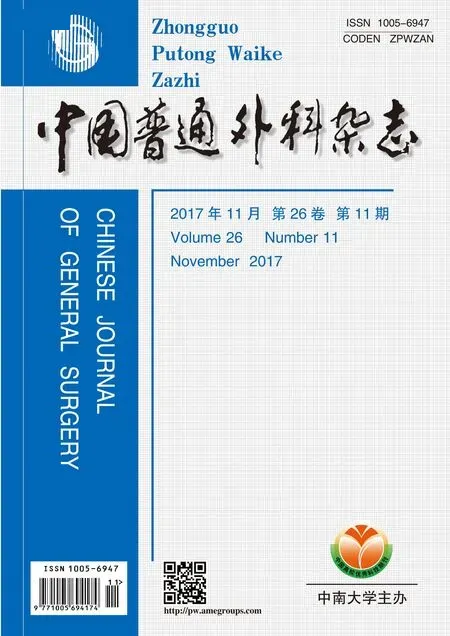MDM2基因启动子区rs2279744位点单核苷酸多态性与乳腺癌发病关系的Meta分析
武亚运,董晓强,王勇攀,王进,张志,毛德利,何宋兵
(1.浙江省嘉善县第一人民医院 普通外科,浙江 嘉善 314100;2.苏州大学附属第一医院 普通外科,江苏 苏州 215006)
WHO早已宣布乳腺癌是女性群体中最常见的恶性肿瘤[1],根据文献[2]报道,2012年全球有新发乳腺癌患者约167.66万例,因乳腺癌死亡患者约52.19万例。对于我国而言,近年来乳腺癌患者的发病率上升趋势显著,而病死率则趋于相对稳定[3],可能是因为近年来女性患者能够做到及时筛查,早期发现,对疾病认识及治疗水平的提高,但是总体来说,其预后仍处于较差水平,根据发展中国家的统计结果显示,乳腺癌患者的5年生存率处于50%~60%范围之内[4]。乳腺癌的发生其实是一个包含多重步骤的进程,在这个进程中有多个因子的参与,尤其是基因的突变,其在乳腺癌的发展过程中担当着不容忽视的角色。鼠双微体基因(murine double minute 2,MDM-2)是1991年从BALB/3T3DM细胞中克隆出来的一种高度扩增基因[5],其定位于染色体12q14.3~q15,包含2个转录启动子序列P1和P2,其转录产物为包含5.5 kb的mRNA[6],编码491个氨基酸,其作为p53功能的负性调节因子,是p53信号途径的重要组成部分[7-8],与肿瘤的发生有密不可分的联系。本研究通过数据库检索,Meta分析的方式,对MDM-2基因rs2279744位点多态性与乳腺癌的发病风险进行评价。
1 资料与方法
1.1 研究的引入和剔除
1.1.1 文献类型 ⑴ 病例对照研究;⑵ 数据完整、可信度高;⑶ 无国别及语种限制;⑷ 对外公开的文献或研究。
1.1.2 研究个体 病例组均为罹患乳腺癌个体,对照组均为未罹患乳腺癌的个体(社区对照与医院对照均包含在内)。
1.1.3 分析因素 MDM2基因rs2279744位点的突变。
1.1.4 可评价指标 rs2279744位点突变型与非突变型在病例与对照中的比例。
1.1.5 剔除 ⑴ 会议论文或摘要,综述以及系统评价类文献;⑵ 中文类硕士学位论文;⑶ 动物实验;⑷ 二次研究。
1.2 文献检索策略
检索的中文数据库包括CBM、WANFANG、及CNKI;英文数据库包括Pubmed、Embase、Web of Science。检索时间均为建库至至2017年7月1日。检索无国别及语种限制。英文检索词包括:breast neoplasm、breast tumor、mammary carcinoma、breast carcinoma、mammary neoplasm、breast cancer、polymorphism、SNP、SNPs、variant、mutation、c-mdm2、mdm-2、mdm2、protooncogene proteins c-mdm2、snp309、309、rs2279744、t-g、t309g;中文检索词包括:乳腺癌、乳腺肿瘤、乳腺恶性肿瘤、乳癌、乳房癌、多态性、多态型、多型性、MDM2、双微体。
1.3 筛选和资料提取
研究的筛选由多名人员完成(n≥3)。主要提取的信息包括:年份、样本量、研究设计类型、测序及基因分型技术、突变与野生型比例等方面内容。
1.4 文献质量及风险评价
此次Meta分析,由于纳入的所有研究类型均为病例-对照研究,选用NOS量表进行质量评价,以其下包含的8个分支小条目作为评分点。高于6分(含6分)的研究才可进行Meta分析。经评价后所有入选文献评分均在6分及6分以上。
1.5 统计学处理
用Stata 14.0对数据进行处理,首先是对照组进行HWE平衡检测,P>0.05方可认为对照组处于HWE平衡状态,对包含的研究应用χ2进行异质性检验分析,I2<50%且P>0.05才表明各个研究之间不存在明显异质性,配合固定效应模型进行分析,否则配合随机效应模型分析。对于二分类变量的计数资料,以比值比(OR)及95%CI作为效应量来评价rs2279744位点单核苷酸多态性与乳腺癌发生的关系,并绘制Egger漏斗图检测发表偏倚,最后进行敏感性分析。检验水准α=0.05。
2 结 果
2.1 文献检索与筛选结果
通过上述数据库,共检索到359篇研究,其中中文75篇,英文284篇。剔除重复发表的研究97篇,排除不相关研究42篇,综述、摘要、会议文献及摘要、系统评价类研究65篇,动物试验23篇,排除非指定位点研究3 0篇,非指定基因研究33篇,非多态性研究35篇,单体型研究4篇,暂时获得研究30篇。进一步阅读文献内容,排除数据不全类研究2篇,最终纳入Meta分析的研究共计28篇。文献检索流程详见图1。

图1 文献检索流程Figure 1 Literature screening process
2.2 纳入文献的一般情况
根据以上纳入、排除标准和质量评价结果,有28篇文献[9-36]纳入Meta分析,其中2项研究HWE非平衡(P<0.05),另外26项研究中均为HWE平衡(P>0.05),共纳入11 804例经确诊的乳腺癌患者以及15 209例对照。

表1 纳入文献的一般情况Table 1 The general information of the included studies
2.3 Meta分析结果
2.3.1 突变型与野生型(TG/GGvs.TT) Meta分析存在异质性(I2=32.8%,P<0.05),应配合随机效应模型进行分析。Meta分析结果显示,TG/GG和TT基因型在病例组与对照组中的差异有 统 计 学 意 义(OR=1.15,95%CI=1.06~1.24,P<0.001)(图2);另外根据人群分为4个亚组,亚洲人群差异有统计学意义(随机效应模型:OR=1.34,95%CI=1.15~1.57,P<0.001; 固定 效 应 模 型:OR=1.34,95%CI=1.20~1.50,P<0.001)(图3),敏感性分析图显示排除任意一项研究后,结果仍具有统计学差异,波动范围在1.20~1.50,说明结论的可靠性(图4)。发表偏倚评估,如图5显示,Egger漏斗图对称,无明显偏倚存在(Egger检验,P=0.971)。

图2 总人群突变型与野生型比较森林图Figure 2 Forest plot of comparison between mutant genotype and wild genotype in overall population

图3 亚洲人群突变型与野生型比较森林图(固定效应模型)Figure 3 Forest plot of comparison between mutant genotype and wild genotype in Asia’s population (Fixed effect model)

图4 突变型与野生型亚洲人群敏感性分析Figure 4 Sensitivity analysis for mutant genotype and wild genotype in Asia’s population
2.3.2 等位基因(Gvs.T) Meta分析存在异质性(I2=46.9%,P<0.05),应配合随机效应模型进行分析。Meta分析结果表明,G和T等位基因病例组与对照组中的比较,差异有统计学意义(OR=1.12,95%=1.05~1.18,P<0.001)(图6);根据人群分为4个亚组,亚洲人群差异有统计学意义(随机效应模 型:OR=1.21,95%CI=1.09~1.35,P=0.001)(图7),敏感性分析图显示排除任意一项研究后,结果仍具有统计学差异,波动范围在1.06~1.39,说明结论的可靠性(图8)。发表偏倚评估显示,Egger漏斗图对称,无明显偏倚存在(Egger,P=0.950)(图9)。
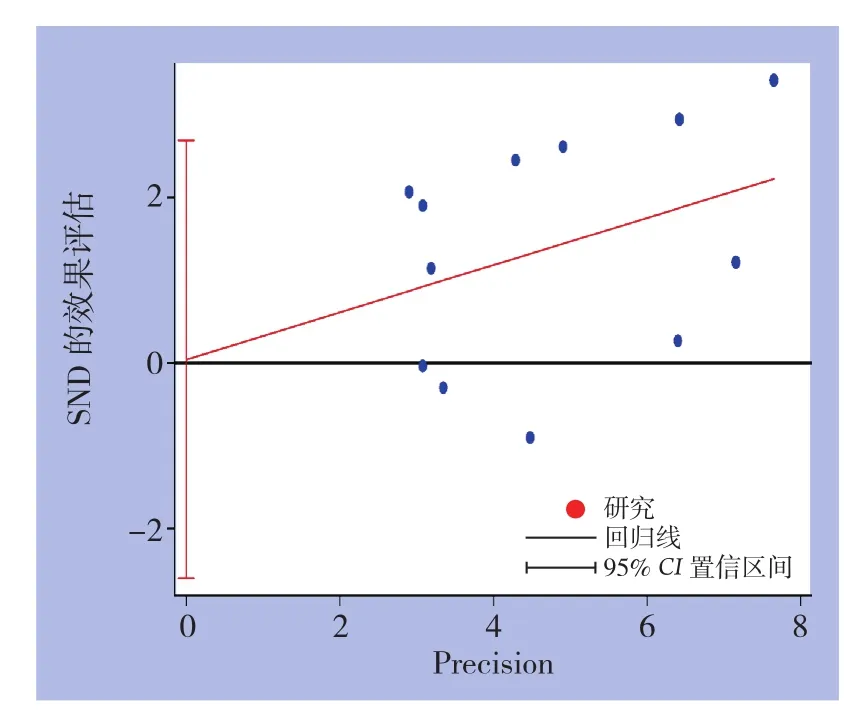
图5 亚洲人群发表偏倚评价(Egger检验,P=0.971)Figure 5 Publication bias assessment for mutant genotype and wild genotype in Asia’s population (Egger’s test,P=0.971)
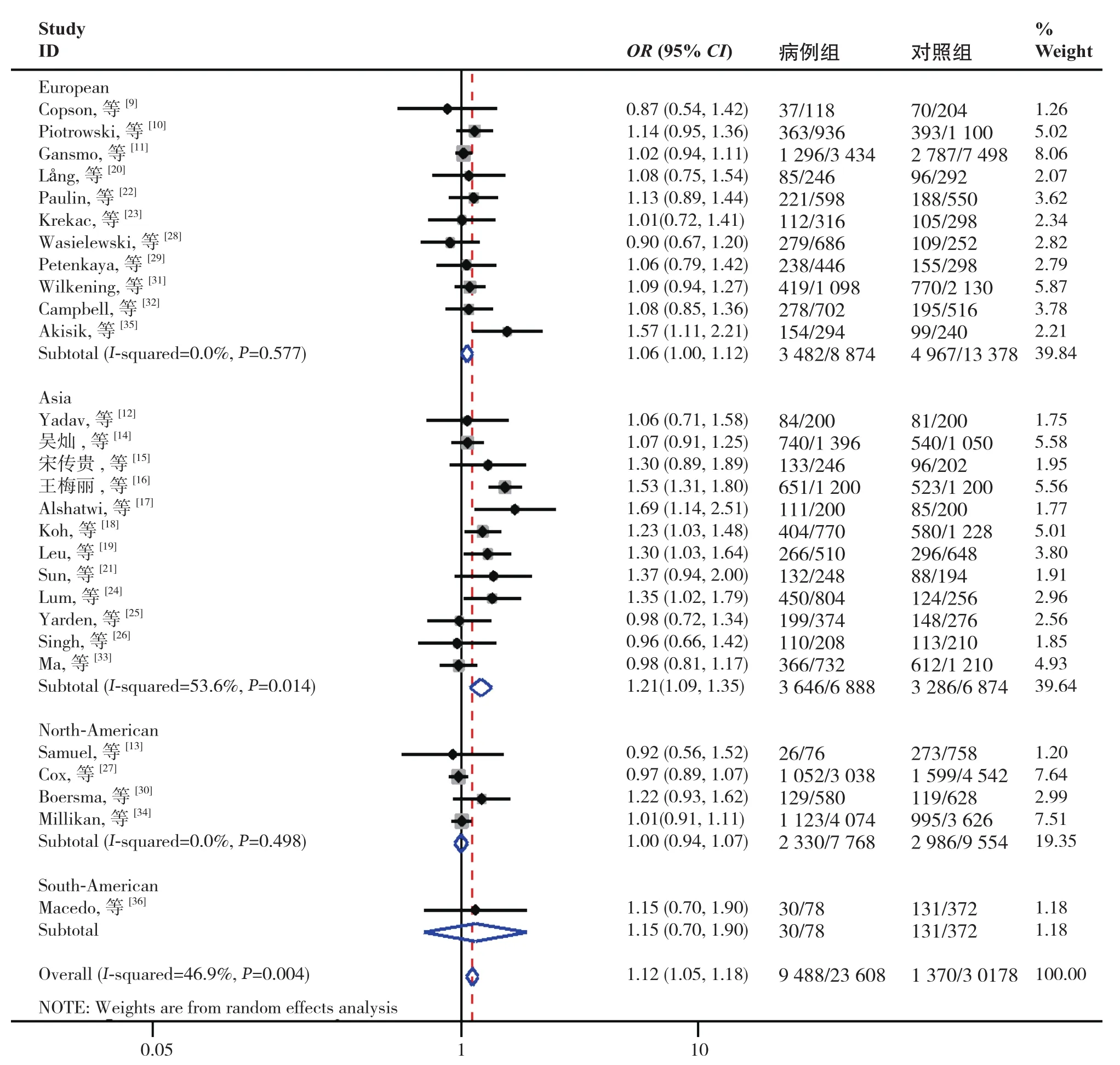
图6 总人群等位基因比较森林图Figure 6 Forest plot of comparison between two alleles in overall population
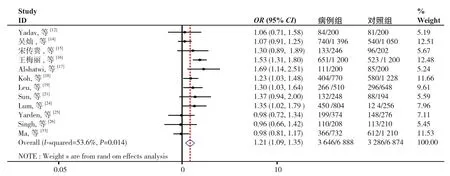
图7 亚洲人群等位基因比较森林图(随机效应模型)Figure 7 Forest plot of comparison between two alleles in Asia’s population (Random effects model)
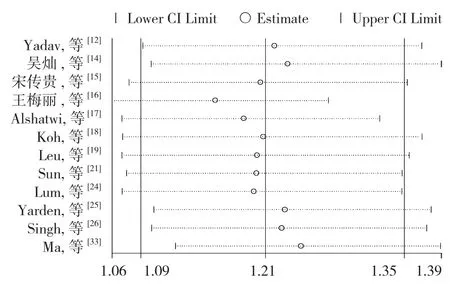
图8 等位基因亚洲人群敏感性分析Figure 8 Sensitivity analysis for alleles in Asia’s population

图9 等位基因亚洲人群发表偏倚评价(Egger,P=0.950)Figure 9 Publication bias assessment for alleles in Asia’s population (Egger’s test, P=0.950)
3 讨 论
单核苷酸多态性是导致基因多样性的常见来源,学术界普遍认同其在个体肿瘤的发生或演变进程中有着不可忽略的作用[37]。MDM2作为一种热门基因,针对MDM2基因多态性与乳腺癌的关系,目前研究较多的位点包括rs2279744[38-39],rs3730485[40-41],rs117039649[11,42],rs1196333[43]。rs2279744位点是位于MDM2基因启动子区内的第309位(T>G)突变,其全球最小等位基因频率G=36.66%,该位点突变与乳腺癌的关系近年来始终是研究的热门话题,更深层的研究[44]认为该位点突变能够使得MDM2转录增强表达增加,研究表明其多态性与其他肿瘤,诸如膀胱癌[45]、口腔癌[46]、子宫内膜癌[47]、结直肠癌[48]、肺癌[49]等也可能存在某种联系。有关rs2279744位点单核苷酸多态性与乳腺癌的关系尚存在诸多争议,Yadav等[12]及Krekac等[23]认为rs2279744位点单核苷酸多态性与乳腺癌无直接关联,Isakova等[50]及Sun等[21]认为MDM2基因rs2279744单核苷酸多态性能显著增加乳腺癌的发病风险。因为存在诸多观点上的争议,故有必要通过资料的收集和Meta分析整合来进一步探讨该基因位点多态性与乳腺癌的风险关联性。
本次研究通过检索国内外知名数据库,筛选出28篇MDM2基因rs2279744单核苷酸多态性与乳腺癌相关的病例对照研究,通过Meta分析,比较病例组与对照组的基因型比例,突变型与野生型(TG/GGvs.TT)有明显差异,等位基因模型下的病例组与对照组G/T等位基因(Gvs.T)有明显差异。但是,经过亚组分析发现,只有在亚洲人群中该位点的突变与乳腺癌发病相关。随后,验证Meta分析结果的稳定性,结果稳定可靠;从漏斗图的图示结果来看,基本对称,提示无发表偏倚或发表偏倚不明显。因此认为,MDM2基因rs2279744位点的突变与亚洲人乳腺癌的发生显著相关,其极有可能成为亚洲人乳腺癌高危患者筛查的新突变位点,甚至成为乳腺癌治疗的新的基因靶点,亟待学者对亚洲人群该位点突变的特殊性进行下一步研究。
综上所述,本研究通过Meta分析对rs2279744位点多态性与乳腺癌的发病风险的关联性做出了评价,就两者关联性得出了肯定的结论。当然本研究也存在一些缺陷和不足,例如检索的数据库数量不够多,纳入研究均为中文和英文文献,尚缺乏其他语言类研究,难免造成一定程度的偏倚风险。但是,笔者认为,此次大样本量的综合研究结果具有一定的临床意义,对于那些存在乳腺癌发病风险的个体的筛查,带来帮助,例如可以作为一项风险评估项目,筛查出高危患者,对于那些进行MDM2基因rs2279744位点与乳腺癌关联的基础研究者,也可作为一定的参考。
[1]Dubey AK, Gupta U, Jain S. Breast cancer statistics and prediction methodology: a systematic review and analysis[J]. Asian Pac J Cancer Prev, 2015, 16(10):4237–4245.
[2]Torre LA, Bray F, Siegel RL, et al. Global cancer statistics, 2012[J].CA Cancer J Clin, 2015, 65(2):87–108. doi: 10.3322/caac.21262.
[3]Chen W, Zheng R, Baade PD, et al. Cancer statistics in China,2015[J]. CA Cancer J Clin, 2016, 66(2):115–132. doi: 10.3322/caac.21338.
[4]Sankaranarayanan R. Cancer survival in Africa, Asia, the Caribbean and Central America. Introduction[J]. IARC Sci Publ, 2011,(162):1–5.
[5]姜力豪. 鼠双微染色体2基因对鳞状细胞癌预后评估的研究进展[J]. 重庆医学, 2013, 42(8):952–954. doi:10.3969/j.issn.1671–8348.2013.08.048.Jiang LH. Research progress of mouse double minute 2 homolog gene in prognostic evaluation of squamous-cell carcinoma[J].Chongqing Medicine, 2013, 42(8):952–954. doi:10.3969/j.issn.1671–8348.2013.08.048.
[6]Oliner JD, Kinzler KW, Meltzer PS, et al. Ampli fi cation of a gene encoding a p53-associated protein in human sarcomas[J]. Nature,1992, 358(6381):80–83.
[7]Mendoza M, Mandani G, Momand J. The MDM2 gene family[J].Biomol Concepts, 2014, 5(1):9–19. doi: 10.1515/bmc-2013–0027.
[8]Zhao Y, Yu H, Hu W. The regulation of MDM2 oncogene and its impact on human cancers[J]. Acta Biochim Biophys Sin (Shanghai),2014, 46(3):180–189. doi: 10.1093/abbs/gmt147.
[9]Copson ER, White H E, Blaydes J P, et al. In fl uence of the MDM2 single nucleotide polymorphism SNP309 on tumour development in BRCA1 mutation carriers[J]. BMC Cancer, 2006,6:80.
[10]Piotrowski P, Lianeri M, Rubis B, et al. Murine double minute clone 2,309T/G and 285G/C promoter single nucleotide polymorphism as a risk factor for breast cancer: a Polish experience[J]. Int J Biol Markers, 2012, 27(2):e105–110. doi: 10.5301/JBM.2012.9140.
[11]Gansmo LB, Knappskog S, Romundstad P, et al. Influence of MDM2 SNP309 and SNP285 status on the risk of cancer in the breast, prostate, lung and colon[J]. Int J Cancer, 2015, 137(1):96–103. doi: 10.1002/ijc.29358.
[12]Yadav P, Masroor M, Tanwer K, et al. Clinical significance of TP53 (R72P) and MDM2 (T309G) polymorphisms in breast cancer patients[J]. Clin Transl Oncol, 2016, 18(7):728–734. doi: 10.1007/s12094–015–1425–5.
[13]Samuel N, Id Said B, Guha T, et al. Assessment of TP53 Polymorphisms and MDM2 SNP309 in Premenopausal Breast Cancer Risk[J]. Hum Mutat, 2017, 38(3):265–268. doi: 10.1002/humu.23154.
[14]吴灿, 徐晔, 欧阳涛, 等. MDM2启动子区309位点基因多态性与乳腺癌风险的关系[J]. 中国肿瘤临床, 2010, 37(3):131–133.doi:10.3969/j.issn.1000–8179.2010.03.003.Wu C, Xu Y, Ouyang T, et al. Association between MDM2 SNP309 Polymorphism and Breast Cancer Risk in Chinese Women[J].Chinese Journal of Clinical Oncology, 2010, 37(3):131–133.doi:10.3969/j.issn.1000–8179.2010.03.003.
[15]宋传贵, 傅芳萌, 吴雪英, 等. MDM2基因SNP309可能与早发性乳腺癌易感性无关:福建病例-对照研究[J]. 中国癌症杂志, 2011,21(4):262–265. doi:10.3969/j.issn.1007–3969.2011.04.005.Song CG, Fu FM, Wu XY, et al. SNP309 in MDM2 gene may be not associated with susceptibility of early-onset breast cancer: report from Fujian province[J]. China Oncology, 2011, 21(4):262–265.doi:10.3969/j.issn.1007–3969.2011.04.005.
[16]王梅丽, 徐云霞, 钱健, 等. 鼠双微体-2基因多态及P53基因多态与乳腺癌易感性的关联研究[J]. 中华预防医学杂志, 2013,47(2):124–128. doi:10.3760/cma.j.issn.0253–9624.2013.02.007.Wang ML, Xu YX, Qian J, et al. Association of murine double minute 2 and P53 polymorphisms with breast cancer susceptibility[J]. Chinese Journal of Preventive Medicine, 2013,47(2):124–128. doi:10.3760/cma.j.issn.0253–9624.2013.02.007.
[17]Alshatwi AA, Hasan TN, Shafi G, et al. A single-nucleotide polymorphism in the TP53 and MDM-2 gene modi fi es breast cancer risk in an ethnic Arab population[J]. Fundam Clin Pharmacol, 2012,26(3):438–443. doi: 10.1111/j.1472–8206.2011.00939.x.
[18]Koh WP, Van Den Berg D, Jin A, et al. Combined effects of MDM2 SNP309 and TP53 R72P polymorphisms, and soy isoflavones on breast cancer risk among Chinese women in Singapore[J]. Breast Cancer Res Treat, 2011, 130(3):1011–1019. doi: 10.1007/s10549–011–1680–2.
[19]Leu JD, Wang CY, Tsai HY, et al. Involvement of p53 R72P polymorphism in the association of MDM2-SNP309 with breast cancer[J]. Oncol Rep, 2011, 25(6):1755–1763. doi: 10.3892/or.2011.1254.
[20]Lång A, Palmebäck Wegman P, Wingren S. The significance of MDM2 SNP309 and p53 Arg72Pro in young women with breast cancer[J]. Oncol Rep, 2009, 22(3):575–579.
[21]Sun YF, Leu JD, Chen SM, et al. Results based on 124 cases of breast cancer and 97 controls from Taiwan suggest that the single nucleotide polymorphism (SNP309) in the MDM2 gene promoter is associated with earlier onset and increased risk of breast cancer[J].BMC Cancer, 2009, 9:13. doi: 10.1186/1471–2407–9–13.
[22]Paulin FE, O'Neill M, McGregor G, et al. MDM2 SNP309 is associated with high grade node positive breast tumours and is in linkage disequilibrium with a novel MDM2 intron 1 polymorphism[J]. BMC Cancer, 2008, 8:281. doi: 10.1186/1471–2407–8–281.
[23]Krekac D, Brozkova K, Knoflickova D, et al. MDM2SNP309 does not associate with elevated MDM2 protein expression or breast cancer risk[J]. Oncology, 2008, 74(1/2):84–87. doi:10.1159/000139135.
[24]Lum SS, Chua HW, Li H, et al. MDM2 SNP309 G allele increases risk but the T allele is associated with earlier onset age of sporadic breast cancers in the Chinese population[J]. Carcinogenesis, 2008,29(4):754–761. doi: 10.1093/carcin/bgn024.
[25]Yarden RI, Friedman E, Metsuyanim S, et al. MDM2 SNP309 accelerates breast and ovarian carcinogenesis in BRCA1 and BRCA2 carriers of Jewish-Ashkenazi descent[J]. Breast Cancer Res Treat, 2008, 111(3):497–504.
[26]Singh V, Rastogi N, Mathur N, et al. Association of polymorphism in MDM-2 and p53 genes with breast cancer risk in Indian women[J]. Ann Epidemiol, 2008, 18(1):48–57.
[27]Cox DG, Deer D, Guo Q, et al. The p53 Arg72Pro and MDM2-309 polymorphisms and risk of breast cancer in the nurses' health studies[J]. Cancer Causes Control, 2007, 18(6):621–625.
[28]Wasielewski M, Nagel J H, Brekelmans C, et al. MDM2 SNP309 accelerates familial breast carcinogenesis independently of estrogen signaling[J]. Breast Cancer Res Treat, 2007, 104(2):153–157.
[29]Petenkaya A, Bozkurt B, Akilli-Ozturk O, et al. Lack of association between the MDM2-SNP309 polymorphism and breast cancer risk[J]. Anticancer Res, 2006, 26(6C):4975–4977.
[30]Boersma BJ, Howe TM, Goodman JE, et al. Association of breast cancer outcome with status of p53 and MDM2 SNP309[J]. J Natl Cancer Inst, 2006, 98(13):911–919.
[31]Wilkening S, Bermejo J L, Burwinkel B, et al. The single nucleotide polymorphism IVS1+309 in mouse double minute 2 does not affect risk of familial breast cancer[J]. Cancer Res, 2006, 66(2):646–648.
[32]Campbell IG, Eccles DM, Choong DY. No association of the MDM2 SNP309 polymorphism with risk of breast or ovarian cancer[J]. Cancer Lett, 2006, 240(2):195–197.
[33]Ma H, Hu Z, Zhai X, et al. Polymorphisms in the MDM2 promoter and risk of breast cancer: a case-control analysis in a Chinese population[J]. Cancer Letters, 2006, 240(2):261–267.
[34]Millikan RC, Heard K, Winkel S, et al. No association between the MDM2 -309 T/G promoter polymorphism and breast cancer in African-Americans or Whites[J]. Cancer Epidemiol Biomarkers Prev, 2006, 15(1):175–177.
[35]Akisik E, Yazici H, Dalay N. ARLTS1, MDM2 and RAD51 gene variations are associated with familial breast cancer[J]. Mol Biol Rep, 2011, 38(1):343–348. doi: 10.1007/s11033–010–0113–3.
[36]Macedo GS, Vieira IA, Vianna FSL, et al. p53 signaling pathway polymorphisms, cancer risk and tumor phenotype in TP53 R337H mutation carriers[J]. Fam Cancer, 2017, doi: 10.1007/s10689–017–0028–4. [Epub ahead of print]
[37]Wilkening S, Bermejo JL, Hemminki K. MDM2 SNP309 and cancer risk: a combined analysis[J]. Carcinogenesis, 2007,28(11):2262–2267.
[38]Zhao E, Cui D, Yuan L, et al. MDM2 SNP309 polymorphism and breast cancer risk: a meta-analysis[J]. Mol Biol Rep, 2012,39(4):3471–3477. doi: 10.1007/s11033–011–1119–1.
[39]Gao J, Kang A, Lin S, et al. Association between MDM2 rs 2279744 polymorphism and breast cancer susceptibility: a metaanalysis based on 9,788 cases and 11,195 controls[J]. Ther Clin Risk Manag, 2014, 10:269–277. doi: 10.2147/TCRM.S60680.
[40]Gallegos-Arreola MP, Márquez-Rosales MG, Sánchez-Corona J, et al. Association of the Del1518 Promoter (rs3730485) Polymorphism in the MDM2 Gene with Breast Cancer in a Mexican Population[J].Ann Clin Lab Sci, 2017, 47(3):291–297.
[41]Gansmo LB, Vatten L, Romundstad P, et al. Associations between the MDM2 promoter P1 polymorphism del1518(rs3730485) and incidence of cancer of the breast, lung, colon and prostate[J]. Oncotarget, 2016, 7(19):28637–28646. doi: 10.18632/oncotarget.8705.
[42]Knappskog S, Lonning P E. MDM2 promoter SNP285 and SNP309; phylogeny and impact on cancer risk[J]. Oncotarget, 2011,2(3):251–258.
[43]Knappskog S, Gansmo L B, Romundstad P, et al. MDM2 promoter SNP344T>A (rs1196333) status does not affect cancer risk[J]. PLoS One, 2012, 7(4):e36263. doi: 10.1371/journal.pone.0036263.
[44]Bond GL, Hu W, Bond EE, et al. A single nucleotide polymorphism in the MDM2 promoter attenuates the p53 tumor suppressor pathway and accelerates tumor formation in humans[J]. Cell, 2004,119(5):591–602.
[45]Xie L, Sun Y, Chen T, et al. Association between MDM2 SNP309 T>G polymorphism and the risk of bladder cancer: new data in a Chinese population and an updated meta-analysis[J]. Onco Targets Ther, 2015, 8:3679–3690. doi: 10.2147/OTT.S95353.
[46]Yang XI, Zhu Y, Ye D, et al. Association of MDM2 promoter T309G polymorphism with oral cancer risk: A meta-analysis of 3,536 subjects[J]. Mol Clin Oncol, 2016, 5(1):175–180.
[47]Zajac A, Smolarz B, Stachowiak G, et al. TP53 and MDM2 polymorphisms and the risk of endometrial cancer in postmenopausal women[J]. Med Oncol, 2014, 31(11):286. doi:10.1007/s12032–014–0286-z.
[48]Wang W, Du M, Gu D, et al. MDM2 SNP309 polymorphism is associated with colorectal cancer risk[J]. Sci Rep, 2014, 4:4851.doi: 10.1038/srep04851.
[49]Kong Q, Li P, Tian Q, et al. Role of MDM2 T309G polymorphism in susceptibility and prognosis of nonsmall cell lung cancer: a metaanalysis[J]. Genet Test Mol Biomarkers, 2014, 18(5):357–365. doi:10.1089/gtmb.2013.0506.
[50]Isakova JT, Talaibekova ET, Makieva KB, et al. Association between XRCC1 ARG399GLN, TP53 ARG72PRO and MDM2 T309G polymorphisms and the risk of breast cancer in women of the Kyrgyz population[J]. Rossiiskii Onkologicheskii Zhurnal,2016, 21(3):131–135.

